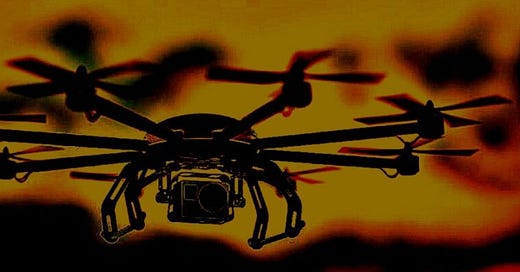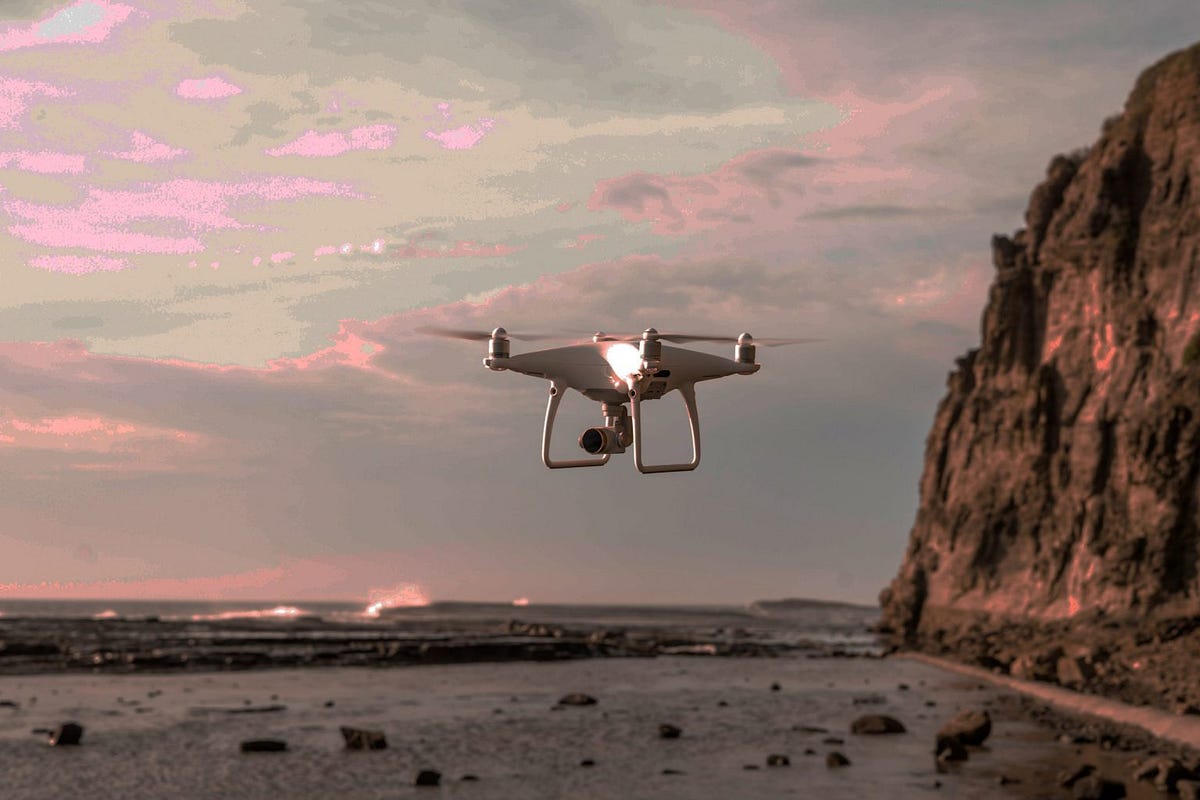Drones and the Police State Pandemic, As Editor, A Sense of Place Magazine, 10 April, 2020.
Drones and the Police State Pandemic

By Ethan Nash with TOTT News
It’s all Going Straight to a Totalitarian Hell
As COVID-19 restrictions tighten across the world, governments are harnessing the potential of drones. From delivering medical supplies, to helping keep people indoors — drones can do a lot in a pandemic.
Like all technologies, the question with drones should be about how they are used. But embedding systems of control that can be turned against civilians is its own disaster in the making.
Surveillance systems, most notably CCTV cameras and advanced biometric technologies, have expanded at an unprecedented rate in Australia since the events of September 11th, and today have become a security staple of governments, private businesses and individuals alike.
Authorities and experts have both raised concerns that some of the most popular brands of cameras, drones and other accessories in Australia, are being used as a surveillance intermediary for foreign entities, particularly the Chinese government.
The prevalence of surveillance drones in both government and police operations has increased tenfold over the last decade, representing a key aspect of advances in tech-driven monitoring.
Drones present a much easier, faster, and cheaper method of image and data collection and they have a number of other key advantages over traditional surveillance.
Drones can enter narrow and confined spaces, get closer to subjects without detection, produce minimal noise and can be equipped with night vision cameras and thermal sensors allowing them to provide imagery that the human eye is unable to detect.
People in Western Australia may soon see more than birds in the sky, as the state’s police force have announced plans to deploy drones to enforce social distancing.Sickness Monitoring is the Opening Video Surveillance Has Been Waiting For | Daniel Miessler
I’ve thought for a long time that public video feed monitoring would become ubiquitous. My basis for this was looking…danielmiessler.com
The drones will visit parks, beaches and cafe strips, ensuring people comply with the most recent round of gathering rules.
These measures may be difficult to rollback once the pandemic passes. And safeguards will be needed to prevent unwanted surveillance in the future.
The main game has been about control.
China is using drones to enforce quarantine rules and deter gatherings that violate social distancing rules.
One viral video showed a drone scolding an elderly woman for not wearing a mask. In some cases, traffic police and municipal officials used drones fitted with speakers to order people home and break up mahjong games.
With high definition and infrared images streamed to command stations, China’s drones use facial recognition to identify specific individuals using its Social Credit System, and fine them for indiscretions.
This level of social control may be appealing in a pandemic that could cost millions of lives. But it could also have chilling effects on social and political life.
Surveillance tools typically work best for social control when people know they are being watched. Even in liberal societies, people might think twice about joining climate or racial justice protests if they know they’ll be recorded by a drone overhead.
The current heightened alarm comes in the wake of a Summer of Surveillance. Even before the pandemic.
It has been revealed Victoria Police are planning to use surveillance drones to monitor Melbourne crowd across the country this summer, in a move that has come under criticism.
“Whilst you may not necessarily see the drone we will be watching your behaviour and we can watch personal watercraft, people on the beaches,” Police Commander Libby Murphy said.
Reports suggest the use of ariel surveillance to ‘stamp down on violence’ will be a significant part of this year’s operation, including the use of technology to monitor individuals:
“There will be a focus on using real-time intelligence and technology through the Drone Unit to detect and deter offending, giving us the ability to flexibly deploy resources to where they’re most needed.
“We know these groups often travel between popular beach locations so we’ll be closely monitoring the public transport network to ensure that everyone can go about their day and night safely.”
The 2017 Guidelines to Surveillance and Privacy in the Victorian Public Sectoroutline that any use of surveillance technology must be ‘necessary, proportionate and for a legitimate purpose related to the activities of the organisation.’
The operation runs until March next year, and has been called a gross violation of privacy by Digital Rights Watch chair Tim Singleton Norton:
“Is it necessary and proportionate for police officers to constantly surveil large numbers of the public, often in a state of undress? For members of the public to have their bodies subjected to surveillance in these circumstances is invasive and often deeply uncomfortable.
Imagine, you are on the beach in your togs and at any moment there could be a police officer — male or female — observing you from the sky? It’s not just a dampener on summer relaxation time, it’s downright creepy.
Our beaches are public areas that everyone should feel free to use without the scrutiny of someone watching from a control room far afield.”
The announcement follows similar moves by other Australian states, with increased use of surveillance drone technology as a means of ‘crime prevention’ spreading across the country.
The establishment already understands the power of this technology, with Australia’s Pine Gap spy base playing a key role in controversial United States drone strikes.
The primary function of the top-secret signals intelligence base near Alice Springs is to track the precise ”geolocation” of radio signals, including hand-held radios and mobile phones.
The drone program, which has involved more than 370 attacks in Pakistan since 2004, is reported to have killed between 2500 and 3500 ‘militants’, and numerous more civilians as “collateral damage”.
This is the same establishment that will spend $7 billion on a fleet of six long-range unmanned drones to monitor the seas around Australia and feed intelligence to the Five Eyes alliance.
A few years ago, Malcolm Turnbull announced the purchase of the country’s first Triton drone, which has the wingspan of a Boeing 737 and will easily be able to complete a lap of the South China Sea after taking off from the Northern Territory.
It was hinted that the drones would one day be used to support a wide range of police operations including the forensic mapping of crime scenes and police tactical operations.
Is this what we are seeing start to unfold across the country?
Why is Australia building an army of ‘eyes in the sky’?
This piece is drawn from three articles first published in TOTT News and republished here with their kind permission.‘Pandemic drones’: Creating a police state?
As COVID-19 restrictions tighten across the world, governments are harnessing the potential of drones. From delivering…tottnews.comSurveillance drones to monitor holiday period
Privacy experts have hit out at reports that Victorian Police plan to operate camera surveillance drones on public…tottnews.comAre Chinese tech companies spying on Australia?
Surveillance systems, most notably CCTV cameras and advanced biometric technologies, have expanded at an unprecedented…tottnews.com





